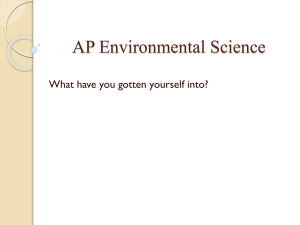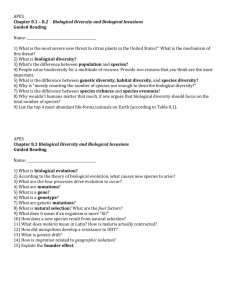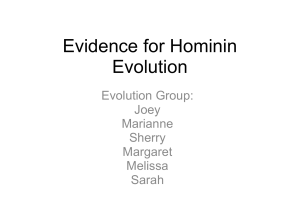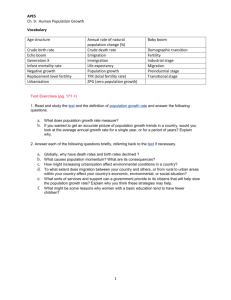APES Test: Air Pollution and Energy Production Calculations Name
advertisement
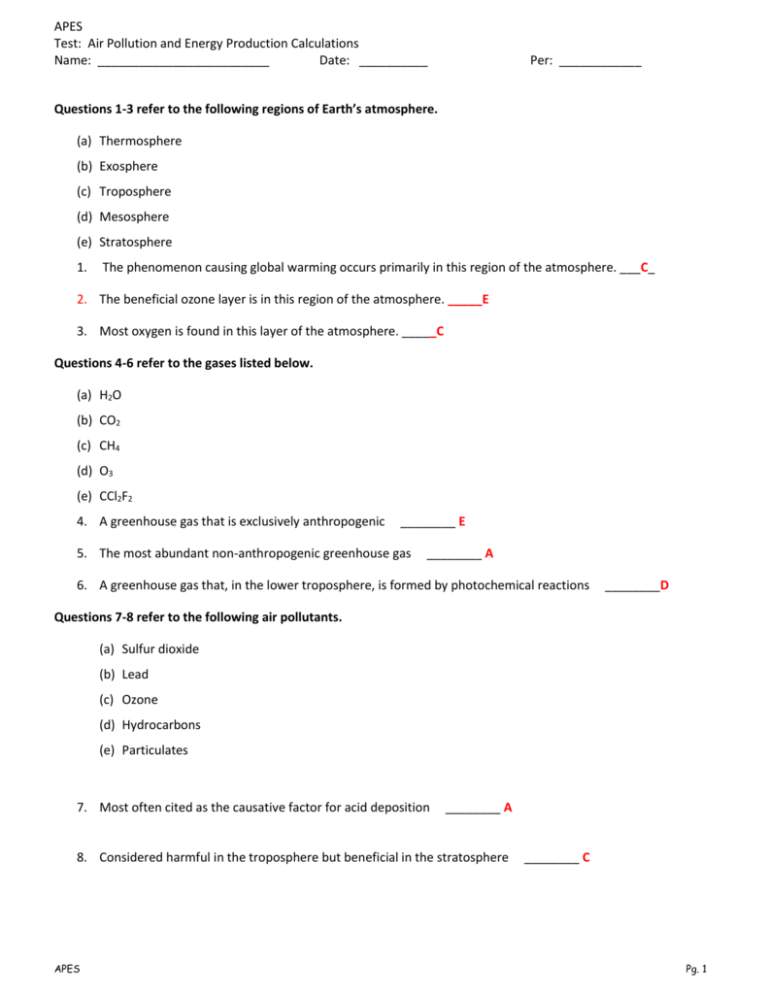
APES Test: Air Pollution and Energy Production Calculations Name: _________________________ Date: __________ Per: ____________ Questions 1-3 refer to the following regions of Earth’s atmosphere. (a) Thermosphere (b) Exosphere (c) Troposphere (d) Mesosphere (e) Stratosphere 1. The phenomenon causing global warming occurs primarily in this region of the atmosphere. ___C_ 2. The beneficial ozone layer is in this region of the atmosphere. _____E 3. Most oxygen is found in this layer of the atmosphere. _____C Questions 4-6 refer to the gases listed below. (a) H2O (b) CO2 (c) CH4 (d) O3 (e) CCl2F2 4. A greenhouse gas that is exclusively anthropogenic ________ E 5. The most abundant non-anthropogenic greenhouse gas ________ A 6. A greenhouse gas that, in the lower troposphere, is formed by photochemical reactions ________D Questions 7-8 refer to the following air pollutants. (a) Sulfur dioxide (b) Lead (c) Ozone (d) Hydrocarbons (e) Particulates 7. Most often cited as the causative factor for acid deposition ________ A 8. Considered harmful in the troposphere but beneficial in the stratosphere APES ________ C Pg. 1 APES Test: Air Pollution and Energy Production Calculations Name: _________________________ Date: __________ Per: ____________ Questions 9-12 refer to the layers of Earth’s atmosphere in the temperature profile shown below. 9. Region where the protective ozone layer is located ________ B 10. Region that contains the majority of molecules in the atmosphere ________ A 11. Region largely responsible for the weather experienced at the Earth’s surface 12. Region with the lowest atmospheric pressure ________ A ________ E Questions 13-16 refer to the substances listed. (a) Asbestos (b) Radon (c) Lead (d) Carbon monoxide (e) Formaldehyde 13. Found in old plumbing pipes and fixtures and some ceramic glazes ______ C 14. Composed of fibers known to cause lung disease ______ A 15. Emitted from most manufactured building materials and furniture ________ E 16. Colorless, odorless gas that is naturally occurring decay product of uranium ______ B APES Pg. 2 APES Test: Air Pollution and Energy Production Calculations Name: _________________________ Date: __________ Per: ____________ Questions 17-18 refer to the following graph. 17. The data in the graph can be useful in explaining the greenhouse effect when they are compared with a. volcanic activity b. sunspot activity c. mean global temperatures d. annual nitrous oxide production e. cycles of flooding and drought 18. The annual fluctuation in carbon dioxide concentration can best be explained by the a. seasonal use of fossil fuels b. regularity of volcanic activity c. deforestation in the tropics d. El Nino events e. seasonal photosynthetic activity of green plants 19. Which of the following is true of carbon as it cycles in nature? a. Carbon dioxide is released during photosynthesis. b. Carbon compounds rarely exist in the gaseous state. c. Carbon sinks include forests and oceans. d. The carbon dioxide concentration in the atmosphere is reduced by cutting trees. e. Carbon is concentrated in sodium chloride solution 20. Which of the following is used to reduce SO2 emissions from coal-burning power plants? a. Catalytic converters b. Ultrafine mechanical filters c. Electrostatic precipitators d. Wet-scrubber units e. Afterburners APES Pg. 3 APES Test: Air Pollution and Energy Production Calculations Name: _________________________ Date: __________ Per: ____________ 21. Which of the following human activities is most closely associated with depletion of the stratospheric ozone layer? a. Mining of coal b. Disposal of refrigerators and air conditioners (because of CFCs) c. Heating of homes and factories d. Generation of electricity e. Agricultural irrigation 22. Which of the following shows the approximate concentration of CO2, N2, and O2 in dry air? CO2 N2 O2 (a) 78% < 1% 21% (b) 43% <1% 56% (c) 36% 8% 56% (d) 10% 70% 20% (e) <1% 78% 21% 23. The atmosphere concentration of carbon dioxide increased from 278 ppm in 1790 to 383 ppm in 2007. What is the approximate percent increase in carbon dioxide concentration from 1790 to 2007? a. 38% b. c. d. e. 50% 92% 105% 138% Cf - Ci -------------- X 100 Ci 24. Of the following cities, which regularly experiences the worst levels of photochemical smog that is enhanced by thermal inversions? a. New York City, New York b. Los Angeles, California c. Portland, Oregon d. Atlanta, Georgia e. Philadelphia, Pennsylvania 25. Possible effects of a warmer atmosphere include which of the following? i. Expanded ranges of tropical diseases ii. More intense hurricanes and typhoons iii. Increased crop damage from pests and diseases a. i only b. ii only c. i and iii only d. ii and iii only e. i, ii, and iii APES Pg. 4 APES Test: Air Pollution and Energy Production Calculations Name: _________________________ Date: __________ Per: ____________ 26. Which of the following is an appropriate remediation strategy for removing radon gas from the home? a. Use filtered water for drinking and bathing. b. Do not occupy the basement of the home. c. Place monitors in suspect areas of the home. d. Remove and replace soil in crawl spaces under the home. e. Seal or ventilate places where radon enters the living space. 27. Which law requires set standards for outdoor air pollutants and emission standards for toxic pollutants? a. Kyoto b. Montreal Protocol c. Clean Air Act d. CERCLA e. Price- Anderson Act 28. When a rainforest is slashed and burned, the local concentration of carbon dioxide in the atmosphere increases. This is primarily due to a. Changes in the local climate b. Oxidation of carbon compounds c. Cellular respiration of rain-forest plants d. Erosion of exposed soil e. Carbon dioxide being released by anaerobic organisms 29. Which of the following is a greenhouse gas that is produced by domestic livestock? a. NO2 b. CH4 c. O3 d. CO e. SO2 30. Which of the following are direct products of the use of hydrocarbon fuels in automobile engines? a. O, N and CO b. CO, Ar, and O3 c. CO2, H2O and O3 d. CO2, O3, and Pb e. CO2, NOx and VOCs 31. The three main anthropogenic sources of gaseous air pollutants in the United States are a. Soil erosion, volcanoes, and forest fires b. Soil erosion, volcanoes, and energy production c. Industry, construction, and agriculture d. Industry, transportation, and energy production e. Industry, transportation, and agriculture APES Pg. 5 APES Test: Air Pollution and Energy Production Calculations Name: _________________________ Date: __________ Per: ____________ 32. Ozone in the stratosphere is most important to life at Earth’s surface because it absorbs a. gamma rays b. microwaves c. ultraviolet light d. visible light e. x-rays 33. Which of the following actions would reduce global greenhouse emissions? a. Increasing the use of automobiles b. Decreasing the number of nuclear power plants c. Replacing coal-burning power plants with wind farms d. Converting tropical forests to rice paddies e. Switching from hydroelectric power generation to power generation using natural gas as the primary fuel 34. The major source of radon in houses in the United States is a. furniture and carpets b. the underlying bedrock c. the troposphere d. nuclear power plants e. fossil-fuel combustion 35. The major human health problem related to radon accumulation is a. lung cancer b. heart disease c. pancreatic cancer d. cataracts e. malignant melanoma 36. Which of the following natural events would most likely contribute to the cooling of Earth’s atmosphere? a. Earthquake b. Volcanism c. Hurricane d. Tsunami e. Monsoon 37. One solution for reducing the amount of atmospheric carbon dioxide would be to a. increase oceanic temperatures to enhance carbon dioxide uptake b. increase the rate of removal of tropical rain forests c. decrease the total area of rice paddies d. decrease the use of fossil fuels e. decrease the production of chlorofluorocarbons APES Pg. 6 APES Test: Air Pollution and Energy Production Calculations Name: _________________________ Date: __________ Per: ____________ 38. Which of the following would be the strongest evidence in support of a scientist’s contention that a local area was experiencing acid deposition? a. b. c. d. e. A sudden die-off of all the fish in a local stream A gradual increase in the temperature of a local lake An increase in the rate of photosynthesis of aquatic plants in a local lake A long-term increase in the pH of a local pond An increase in the concentration of soluble heavy metals in a local pond (due to runoff from soil) 39. If mean global temperature keeps on increasing as predicted by contemporary scientists, which of the following is most likely? a. b. c. d. e. There will be fewer insect pests and disease-carrying organisms. Specialist species living in fragile ecosystems will risk extinction. There will be an increase in sulfate concentrations in wetlands. There will be an increase in the reproductive rate of mammals. The geographical range of many plants will move toward the equator. 40. pH range is from a. 0 – 14 b. c. d. e. 1 -14 0–7 7 -14 0 -12 Questions 41 – 43 refer to the following conditions (a) Asbestosis (b) Mesothelioma (c) Sick building syndrome 41. B is an inoperable cancer of the chest cavity lining caused by the inhalation of asbestos. Common workers that are impacted are insulator installers, pipe fitters, and shipyard employees. 42. C causes flu like symptoms. Characterized when 20% of its occupants suffer persistent symptoms that stop when the person is in ambient areas. 43. A is the inflammation of lung tissue caused by the inhalation of asbestos. Causes breathing difficulty and can be fatal. APES Pg. 7 APES Test: Air Pollution and Energy Production Calculations Name: _________________________ Date: __________ Per: ____________ 44. Which of the following treaties is responsible for lower levels of CFC production worldwide? a. Montreal Protocol b. Kyoto Protocol c. Clean Air Act d. The Rio Earth Summit of 1972 e. CERCLA (Comprehensive Environmental Response Compensation and Liability Act) 45. Which of the following forms of radiation is most harmful to humans? a. Alpha b. Gamma c. Beta d. Infrared e. Radon 46. The energy needed to produce ozone comes from which of the following: a. Oxygen b. Sunlight c. Radioactive decay d. Magma e. Wind 47. Which of the following chemicals can cause lung irritation in the troposphere but is very helpful to humans in the stratosphere? a. O2 b. O3 c. O4 d. Chlorofluorocarbons e. DDT Questions 48 – 50 refer to the following forms of air pollution (A) O3 (B) SO2 (C) Pollen (D) Soot (E) Hydrocarbons 48. This gas originates from the combustion of coal. B 49. One source of this is spilled gasoline - E 50. This is produced by a biotic factor and can cause allergic reactions. C APES Pg. 8 APES Test: Air Pollution and Energy Production Calculations Name: _________________________ Date: __________ APES Per: ____________ Pg. 9 APES Test: Air Pollution & Energy Production Calculations Name: _________________________________Date: ______________ Period: ___________ APES Pg. 10


